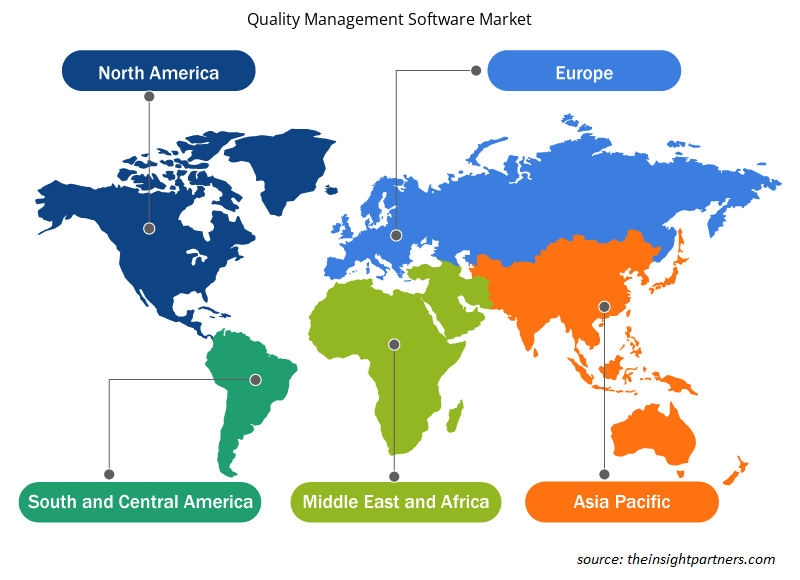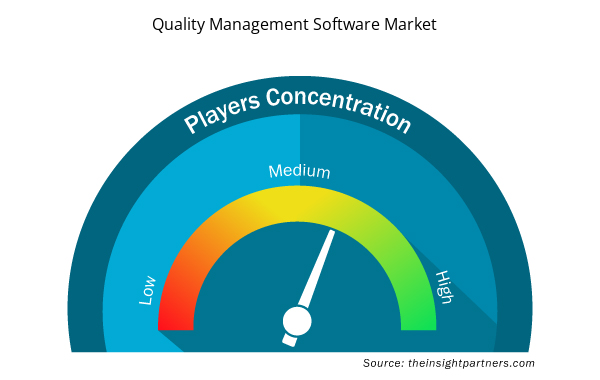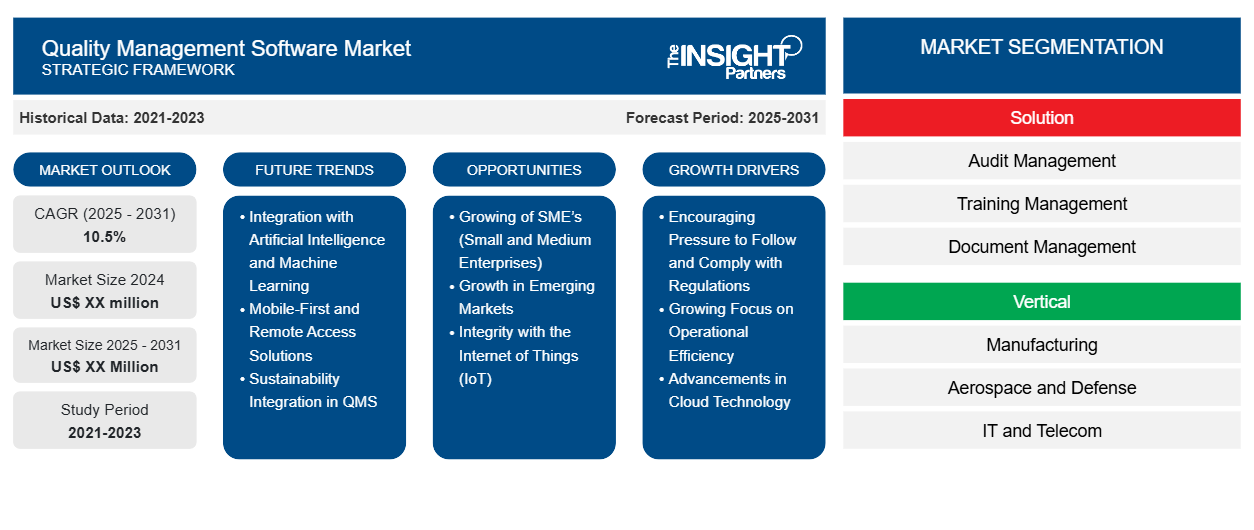من المتوقع أن يسجل سوق برمجيات إدارة الجودة معدل نمو سنوي مركب بنسبة 10.5٪ من عام 2024 إلى عام 2031، مع توسع حجم السوق من XX مليون دولار أمريكي في عام 2024 إلى XX مليون دولار أمريكي بحلول عام 2031.
تم تقسيم تقرير أبحاث السوق حول سوق برامج إدارة الجودة حسب نوع الحل ونوع النشر وحجم المنظمة والقطاع الرأسي. يشمل التوزيع الإقليمي الأسواق والمناطق الرئيسية لإعطاء نظرة عامة عالمية على ديناميكيات السوق. قيم السوق حسب القطاع بالدولار الأمريكي (US$) وتأتي مع تقديرات معدل النمو السنوي المركب التي تساعد في فهم الاتجاهات والديناميكيات والمنافسة في مناطق وتطبيقات مختلفة.
غرض التقرير
يهدف تقرير سوق برامج إدارة الجودة الصادر عن The Insight Partners إلى وصف المشهد الحالي والنمو المستقبلي وأهم العوامل الدافعة والتحديات والفرص. وسيوفر هذا رؤى لمختلف أصحاب المصلحة في الأعمال التجارية، مثل:
- مزودي/مصنعي التكنولوجيا: لفهم ديناميكيات السوق المتطورة ومعرفة فرص النمو المحتملة، وتمكينهم من اتخاذ قرارات استراتيجية مستنيرة.
- المستثمرون: إجراء تحليل شامل للاتجاهات فيما يتعلق بمعدل نمو السوق، وتوقعات السوق المالية، والفرص المتاحة عبر سلسلة القيمة.
- الهيئات التنظيمية: لتنظيم السياسات ومراقبة الأنشطة في السوق بهدف تقليل الانتهاكات والحفاظ على ثقة المستثمرين والحفاظ على سلامة السوق واستقرارها.
تجزئة سوق برامج إدارة الجودة
حل
- إدارة التدقيق
- إدارة التدريب
- إدارة المستندات
- إدارة الشكاوى
- إدارة كابا
- تسجيل المنتج
- تغيير التحكم
- إدارة جودة الموردين
- إدارة الصحة والسلامة والبيئة
رَأسِيّ
- تصنيع
- الفضاء والدفاع
- تكنولوجيا المعلومات والاتصالات
- السلع الاستهلاكية والتجزئة
- الرعاية الصحية
- الطاقة والمرافق
قم بتخصيص هذا التقرير ليناسب متطلباتك
ستحصل على تخصيص لأي تقرير - مجانًا - بما في ذلك أجزاء من هذا التقرير، أو تحليل على مستوى الدولة، وحزمة بيانات Excel، بالإضافة إلى الاستفادة من العروض والخصومات الرائعة للشركات الناشئة والجامعات
- احصل على أهم اتجاهات السوق الرئيسية لهذا التقرير.ستتضمن هذه العينة المجانية تحليلاً للبيانات، بدءًا من اتجاهات السوق وحتى التقديرات والتوقعات.
عوامل نمو سوق برامج إدارة الجودة
- تشجيع الضغط على اتباع اللوائح والامتثال لها: الطلب على الامتثال والامتثال التنظيمي يتزايد في كل الأوقات مع تعرض الصناعات لضغوط تنظيمية متزايدة، أصبح نظام إدارة الجودة ضروريًا للامتثال. تتبنى شركات الأدوية والرعاية الصحية والتصنيع وغيرها نظام إدارة الجودة للتخفيف من التعرض لمخاطر الامتثال. وفقًا لمسح أجرته شركة ديلويت، "يحتل الامتثال التنظيمي مرتبة عالية في قائمة الأسباب التي تدفع المؤسسات إلى تنفيذ برامج المؤسسات"، مما يؤدي إلى اختراق السوق وتبنيها.
- التركيز المتزايد على الكفاءة التشغيلية: يعد تحسين العمليات والعمليات أحد المحركات الأساسية لسوق أنظمة إدارة الجودة. يمكن للشركات العمل بشكل أكثر إنتاجية وبتكلفة فعالة والحصول على معدل تبني أعلى من خلال أتمتة وظائف مراقبة الجودة وتطوير المنتجات والتوثيق.
- التطورات في تكنولوجيا السحابة: الانتقال إلى منصات إدارة الجودة السحابية يوفر للمؤسسات خيارات قابلة للتطوير واقتصادية وقابلة للتكيف. ويعزى نمو السوق إلى حلول السحابة، التي تجدها الشركات مريحة وأرخص مقارنة بالبرامج التقليدية المتوفرة في الموقع وقابلة للتطوير. ووفقًا لشركة Gartner، فإن 40% من المؤسسات تنقل تطبيقات إدارة الجودة الخاصة بها إلى السحابة بحلول عام 2026 للمساعدة في دفع السوق.
الاتجاهات المستقبلية لسوق برامج إدارة الجودة
- التكامل مع الذكاء الاصطناعي والتعلم الآلي:
من المتوقع أن يعمل الذكاء الاصطناعي والتعلم الآلي على تعزيز قدرات حلول إدارة الجودة من خلال تمكين التحليلات التنبؤية وتحسين عملية اتخاذ القرار وتعزيز عمليات مراقبة الجودة. ستساعد هذه التقنيات المتقدمة الشركات على تحديد مشكلات الجودة قبل تفاقمها. - حلول الوصول عن بعد والهواتف المحمولة:
مع تزايد اعتماد الشركات على نماذج العمل عن بعد والهجينة، هناك حاجة متزايدة إلى حلول إدارة الجودة التي تدعمها الهواتف المحمولة. تتيح هذه المنصات للموظفين الوصول إلى أنظمة إدارة الجودة من أي مكان، مما يبسط التعاون واتخاذ القرارات في الوقت الفعلي. - دمج الاستدامة في أنظمة إدارة الجودة:
هناك تركيز متزايد على الاستدامة، حيث تتبنى الشركات أنظمة إدارة الجودة لضمان أن عملياتها ومنتجاتها تلبي المعايير البيئية. ستصبح ميزات الاستدامة بشكل متزايد جزءًا أساسيًا من أنظمة إدارة الجودة، بما يتماشى مع أهداف المسؤولية الاجتماعية للشركات الأوسع نطاقًا.
فرص سوق برامج إدارة الجودة
- نمو الشركات الصغيرة والمتوسطة: كانت الشركات الأكبر حجمًا هي الأولى، لكن أصحاب الشركات الصغيرة بدأوا في الاستفادة من برامج إدارة الجودة ليصبحوا أكثر كفاءة وأقل إهدارًا وأكثر كفاءة. سيتمتع هذا القطاع بإمكانات نمو هائلة مع تزايد توفر حلول إدارة الجودة القابلة للتطوير ومنخفضة التكلفة.
ووفقًا لمؤسسة التمويل الدولية (IFC)، من المتوقع أن تنفق أكثر من 60% من الشركات الصغيرة والمتوسطة الحجم في جميع أنحاء العالم على الحلول الرقمية بحلول عام 2026، مما يزيد من حجم السوق وحصة سوق مزودي أنظمة إدارة الجودة. - النمو في الأسواق الناشئة: تتمتع الأسواق الناشئة مثل منطقة آسيا والمحيط الهادئ وأمريكا اللاتينية بمعدلات تصنيع عالية تسمح باستخدام أنظمة إدارة الجودة في صناعات مثل السيارات والأدوية والسلع الاستهلاكية. وسوف يزداد الطلب على حلول أنظمة إدارة الجودة مع تحديث هذه الأسواق لوظائف التصنيع والتنظيم. ويتوقع تقرير صادر عن البنك الدولي أنه بحلول عام 2025، ستضم منطقة آسيا والمحيط الهادئ أكثر من نصف الصناعات التحويلية في العالم، مما يزيد من السوق المحتملة لحلول أنظمة إدارة الجودة.
- التكامل مع إنترنت الأشياء: سيخلق نظام إدارة الجودة وإنترنت الأشياء معًا إمكانات جديدة لتحليل البيانات في الوقت الفعلي والمراقبة عن بُعد ومراقبة الجودة التنبؤية. يمكن لنظام إدارة الجودة المدعوم من إنترنت الأشياء تحسين عملية مراقبة الجودة في الشركة من خلال تسليط الضوء على المشكلات واقتراح التدابير العلاجية على الفور. تقدر شركة Cisco في عام 2023 أن سوق إنترنت الأشياء ستبلغ قيمتها 1.6 تريليون دولار بحلول عام 2025، مما يعني أن هناك فرصة جيدة لحلول نظام إدارة الجودة للاتصال بإنترنت الأشياء والمساعدة في تحسين الجودة والاستحواذ على حصة في السوق.
رؤى إقليمية حول سوق برامج إدارة الجودة
لقد قام المحللون في Insight Partners بشرح الاتجاهات والعوامل الإقليمية المؤثرة على سوق برامج إدارة الجودة طوال فترة التوقعات بشكل شامل. يناقش هذا القسم أيضًا قطاعات سوق برامج إدارة الجودة والجغرافيا في جميع أنحاء أمريكا الشمالية وأوروبا ومنطقة آسيا والمحيط الهادئ والشرق الأوسط وأفريقيا وأمريكا الجنوبية والوسطى.

- احصل على البيانات الإقليمية المحددة لسوق برامج إدارة الجودة
نطاق تقرير سوق برامج إدارة الجودة
| سمة التقرير | تفاصيل |
|---|---|
| حجم السوق في عام 2024 | XX مليون دولار أمريكي |
| حجم السوق بحلول عام 2031 | XX مليون دولار أمريكي |
| معدل النمو السنوي المركب العالمي (2025 - 2031) | 10.5% |
| البيانات التاريخية | 2021-2023 |
| فترة التنبؤ | 2025-2031 |
| القطاعات المغطاة | حسب الحل
|
| المناطق والدول المغطاة | أمريكا الشمالية
|
| قادة السوق وملفات تعريف الشركات الرئيسية |
|
كثافة اللاعبين في سوق برامج إدارة الجودة: فهم تأثيرها على ديناميكيات الأعمال
يشهد سوق برامج إدارة الجودة نموًا سريعًا، مدفوعًا بالطلب المتزايد من المستخدم النهائي بسبب عوامل مثل تفضيلات المستهلك المتطورة والتقدم التكنولوجي والوعي المتزايد بفوائد المنتج. ومع ارتفاع الطلب، تعمل الشركات على توسيع عروضها والابتكار لتلبية احتياجات المستهلكين والاستفادة من الاتجاهات الناشئة، مما يؤدي إلى زيادة نمو السوق.
تشير كثافة اللاعبين في السوق إلى توزيع الشركات أو المؤسسات العاملة في سوق أو صناعة معينة. وهي تشير إلى عدد المنافسين (اللاعبين في السوق) الموجودين في مساحة سوق معينة نسبة إلى حجمها أو قيمتها السوقية الإجمالية.
الشركات الرئيسية العاملة في سوق برمجيات إدارة الجودة هي:
- شركة أوتوديسك
- أنظمة داسو
- شركة هيوليت باكارد لتطوير المشاريع
- آي بي إم
- شركة ماستر كنترول
إخلاء المسؤولية : الشركات المذكورة أعلاه ليست مرتبة بأي ترتيب معين.

- احصل على نظرة عامة على أهم اللاعبين الرئيسيين في سوق برامج إدارة الجودة
نقاط البيع الرئيسية
- التغطية الشاملة: يغطي التقرير بشكل شامل تحليل المنتجات والخدمات والأنواع والمستخدمين النهائيين لسوق برامج إدارة الجودة، مما يوفر صورة شاملة.
- تحليل الخبراء: تم تجميع التقرير على أساس الفهم العميق لخبراء الصناعة والمحللين.
- معلومات محدثة: يضمن التقرير أهمية الأعمال التجارية بسبب تغطيته للمعلومات الحديثة واتجاهات البيانات.
- خيارات التخصيص: يمكن تخصيص هذا التقرير لتلبية متطلبات العملاء المحددة وبما يتناسب مع استراتيجيات العمل بشكل مناسب.
وبالتالي، يمكن أن يساعد تقرير البحث حول سوق برامج إدارة الجودة في تمهيد الطريق لفك شفرة وفهم سيناريو الصناعة وآفاق النمو. ورغم وجود بعض المخاوف المشروعة، فإن الفوائد الإجمالية لهذا التقرير تميل إلى التفوق على العيوب.
- التحليل التاريخي (سنتان)، السنة الأساسية، التوقعات (7 سنوات) مع معدل النمو السنوي المركب
- تحليل PEST و SWOT
- حجم السوق والقيمة / الحجم - عالميًا وإقليميًا وقطريًا
- الصناعة والمنافسة
- مجموعة بيانات Excel



Report Coverage
Revenue forecast, Company Analysis, Industry landscape, Growth factors, and Trends

Segment Covered
This text is related
to segments covered.

Regional Scope
North America, Europe, Asia Pacific, Middle East & Africa, South & Central America

Country Scope
This text is related
to country scope.
الأسئلة الشائعة
Key companies operating in this market are - Autodesk Inc, Dassault Systèmes, Hewlett Packard Enterprise Development LP, IBM, MasterControl Inc, Microsoft, Oracle, SAP SE, Siemens AG
The report can be delivered in PDF/PPT format; we can also share excel dataset based on the request.
Some of the customization options available based on request are additional 3-5 company profiles and country-specific analysis of 3-5 countries of your choice. Customizations are to be requested/discussed before making final order confirmation, as our team would review the same and check the feasibility.
The market is expected to grow at a CAGR of 10.5% by 2031.
The increasing demand for regulatory compliance, operational efficiency, and cloud-based solutions are driving the Quality Management Software market. Advancements in AI and machine learning also enhance predictive capabilities, fueling market growth.
Future trends in the Quality Management Software market include AI and machine learning integration, mobile-first solutions for remote access, and a growing focus on sustainability, enhancing operational efficiency and regulatory compliance.
Trends and growth analysis reports related to Technology, Media and Telecommunications : READ MORE..
1.Autodesk Inc.
2.Dassault Systèmes
3.Hewlett Packard Enterprise Development LP
4.IBM
5.MasterControl Inc.
6.Microsoft
7.Oracle
8.SAP SE.
9.Siemens AG
10.Sparta Systems, Inc.
The Insight Partners performs research in 4 major stages: Data Collection & Secondary Research, Primary Research, Data Analysis and Data Triangulation & Final Review.
- Data Collection and Secondary Research:
As a market research and consulting firm operating from a decade, we have published and advised several client across the globe. First step for any study will start with an assessment of currently available data and insights from existing reports. Further, historical and current market information is collected from Investor Presentations, Annual Reports, SEC Filings, etc., and other information related to company’s performance and market positioning are gathered from Paid Databases (Factiva, Hoovers, and Reuters) and various other publications available in public domain.
Several associations trade associates, technical forums, institutes, societies and organization are accessed to gain technical as well as market related insights through their publications such as research papers, blogs and press releases related to the studies are referred to get cues about the market. Further, white papers, journals, magazines, and other news articles published in last 3 years are scrutinized and analyzed to understand the current market trends.
- Primary Research:
The primarily interview analysis comprise of data obtained from industry participants interview and answers to survey questions gathered by in-house primary team.
For primary research, interviews are conducted with industry experts/CEOs/Marketing Managers/VPs/Subject Matter Experts from both demand and supply side to get a 360-degree view of the market. The primary team conducts several interviews based on the complexity of the markets to understand the various market trends and dynamics which makes research more credible and precise.
A typical research interview fulfils the following functions:
- Provides first-hand information on the market size, market trends, growth trends, competitive landscape, and outlook
- Validates and strengthens in-house secondary research findings
- Develops the analysis team’s expertise and market understanding
Primary research involves email interactions and telephone interviews for each market, category, segment, and sub-segment across geographies. The participants who typically take part in such a process include, but are not limited to:
- Industry participants: VPs, business development managers, market intelligence managers and national sales managers
- Outside experts: Valuation experts, research analysts and key opinion leaders specializing in the electronics and semiconductor industry.
Below is the breakup of our primary respondents by company, designation, and region:

Once we receive the confirmation from primary research sources or primary respondents, we finalize the base year market estimation and forecast the data as per the macroeconomic and microeconomic factors assessed during data collection.
- Data Analysis:
Once data is validated through both secondary as well as primary respondents, we finalize the market estimations by hypothesis formulation and factor analysis at regional and country level.
- Macro-Economic Factor Analysis:
We analyse macroeconomic indicators such the gross domestic product (GDP), increase in the demand for goods and services across industries, technological advancement, regional economic growth, governmental policies, the influence of COVID-19, PEST analysis, and other aspects. This analysis aids in setting benchmarks for various nations/regions and approximating market splits. Additionally, the general trend of the aforementioned components aid in determining the market's development possibilities.
- Country Level Data:
Various factors that are especially aligned to the country are taken into account to determine the market size for a certain area and country, including the presence of vendors, such as headquarters and offices, the country's GDP, demand patterns, and industry growth. To comprehend the market dynamics for the nation, a number of growth variables, inhibitors, application areas, and current market trends are researched. The aforementioned elements aid in determining the country's overall market's growth potential.
- Company Profile:
The “Table of Contents” is formulated by listing and analyzing more than 25 - 30 companies operating in the market ecosystem across geographies. However, we profile only 10 companies as a standard practice in our syndicate reports. These 10 companies comprise leading, emerging, and regional players. Nonetheless, our analysis is not restricted to the 10 listed companies, we also analyze other companies present in the market to develop a holistic view and understand the prevailing trends. The “Company Profiles” section in the report covers key facts, business description, products & services, financial information, SWOT analysis, and key developments. The financial information presented is extracted from the annual reports and official documents of the publicly listed companies. Upon collecting the information for the sections of respective companies, we verify them via various primary sources and then compile the data in respective company profiles. The company level information helps us in deriving the base number as well as in forecasting the market size.
- Developing Base Number:
Aggregation of sales statistics (2020-2022) and macro-economic factor, and other secondary and primary research insights are utilized to arrive at base number and related market shares for 2022. The data gaps are identified in this step and relevant market data is analyzed, collected from paid primary interviews or databases. On finalizing the base year market size, forecasts are developed on the basis of macro-economic, industry and market growth factors and company level analysis.
- Data Triangulation and Final Review:
The market findings and base year market size calculations are validated from supply as well as demand side. Demand side validations are based on macro-economic factor analysis and benchmarks for respective regions and countries. In case of supply side validations, revenues of major companies are estimated (in case not available) based on industry benchmark, approximate number of employees, product portfolio, and primary interviews revenues are gathered. Further revenue from target product/service segment is assessed to avoid overshooting of market statistics. In case of heavy deviations between supply and demand side values, all thes steps are repeated to achieve synchronization.
We follow an iterative model, wherein we share our research findings with Subject Matter Experts (SME’s) and Key Opinion Leaders (KOLs) until consensus view of the market is not formulated – this model negates any drastic deviation in the opinions of experts. Only validated and universally acceptable research findings are quoted in our reports.
We have important check points that we use to validate our research findings – which we call – data triangulation, where we validate the information, we generate from secondary sources with primary interviews and then we re-validate with our internal data bases and Subject matter experts. This comprehensive model enables us to deliver high quality, reliable data in shortest possible time.


 احصل على عينة مجانية لهذا التقرير
احصل على عينة مجانية لهذا التقرير